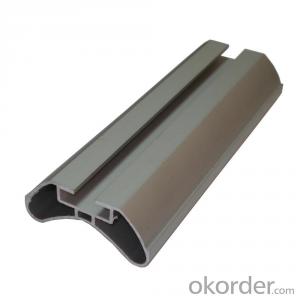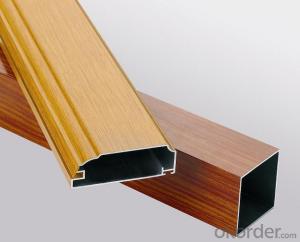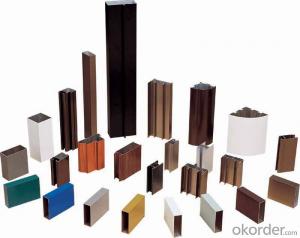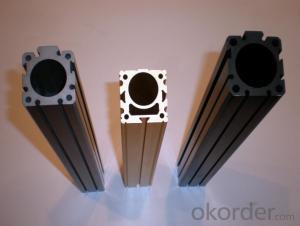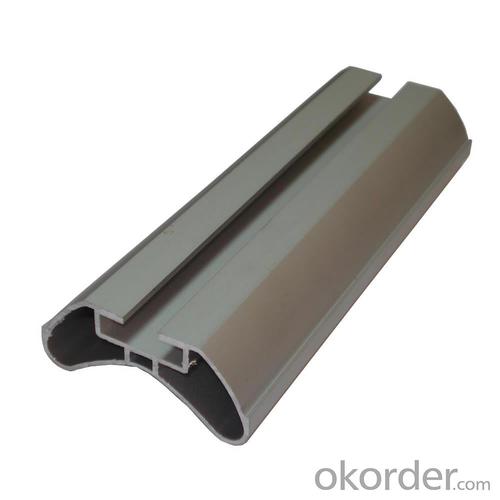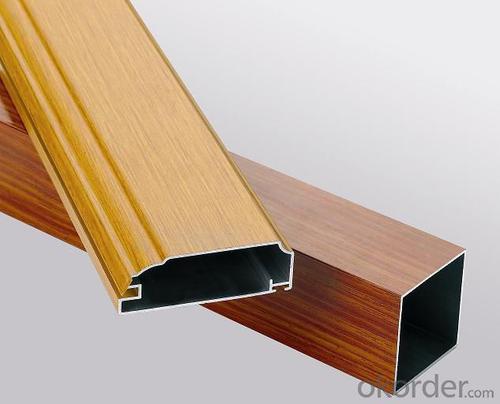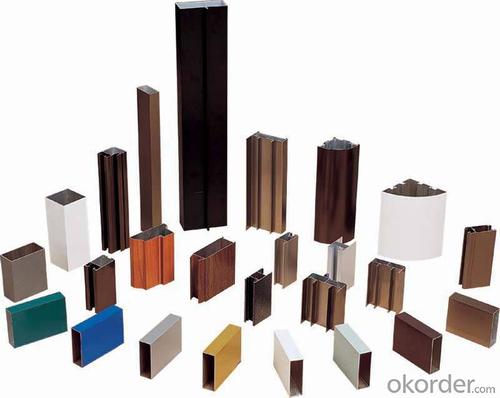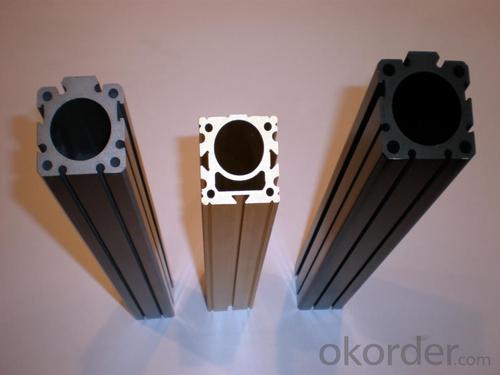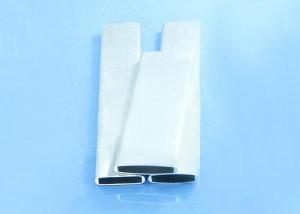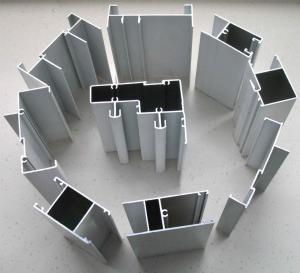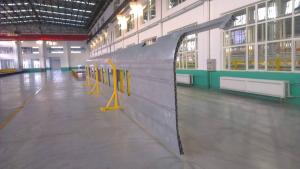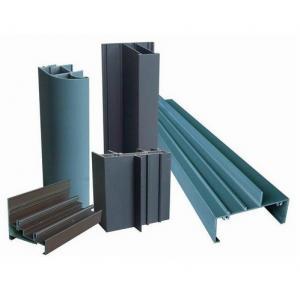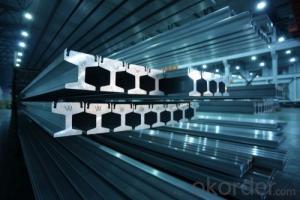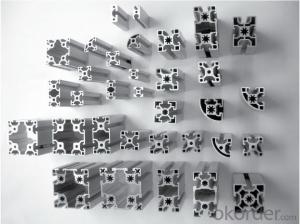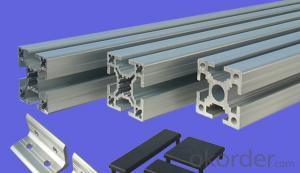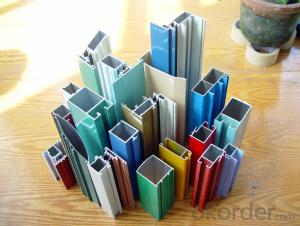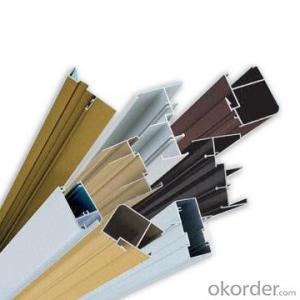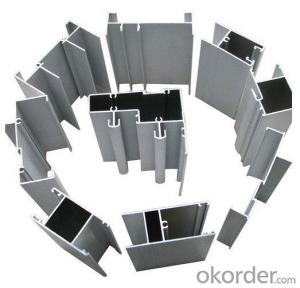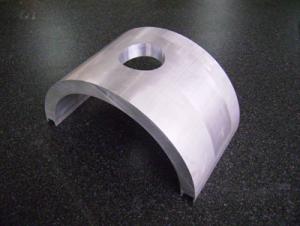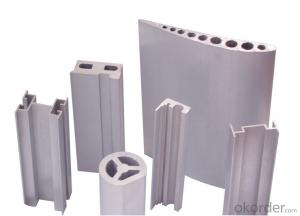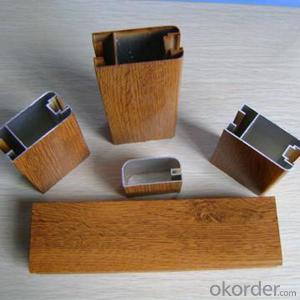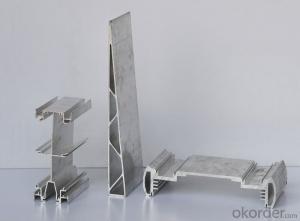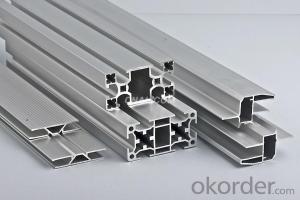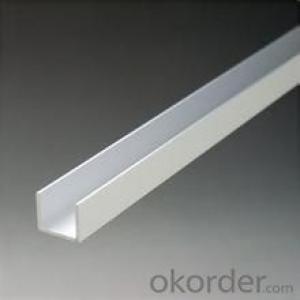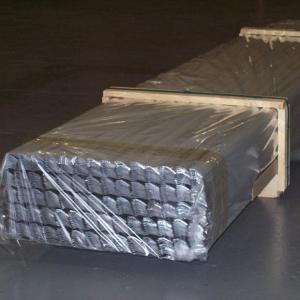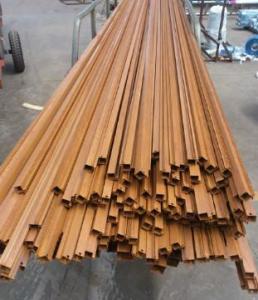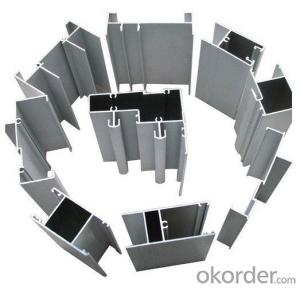China Powder Coated Aluminum Profiles - Manufacturing Aluminium Profile
- Loading Port:
- China Main Port
- Payment Terms:
- TT OR LC
- Min Order Qty:
- -
- Supply Capability:
- -
OKorder Service Pledge
OKorder Financial Service
You Might Also Like
Aluminium profile
1) Alloy: AA6061, AA6063
2) Temper: T5, T6
3) Series of surface treament:
1. Mill Finished
2. Anodizing: Silver, champagne, light bronze, dark bronze, black, light titanium, dark titanium.
3. Electrophoretic Coating: Silver, champagne, bronze, black, light bronze, dark bronze.
4. Electrostatic Color Powder Coating: Normal color, special color.
5. Fluorocarbon Powder Spraying: Normal color, special color.
6. Wood Grain Coating: Import paper, domestic paper.
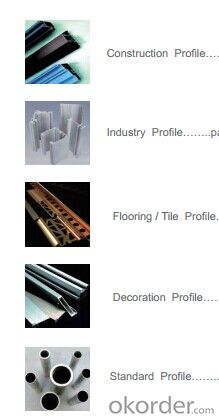
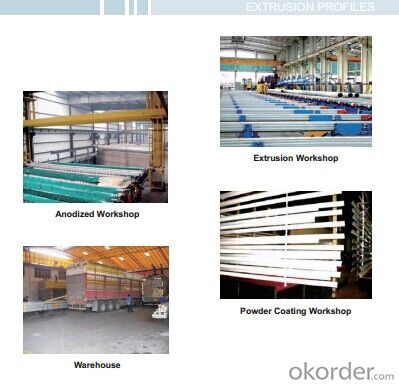
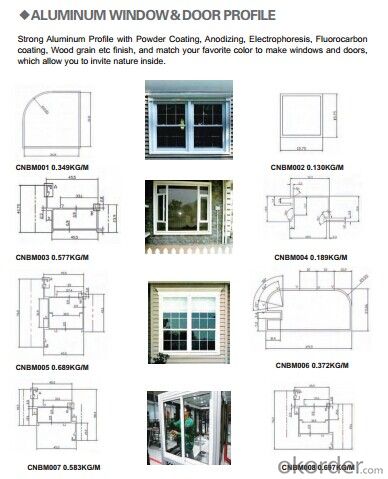
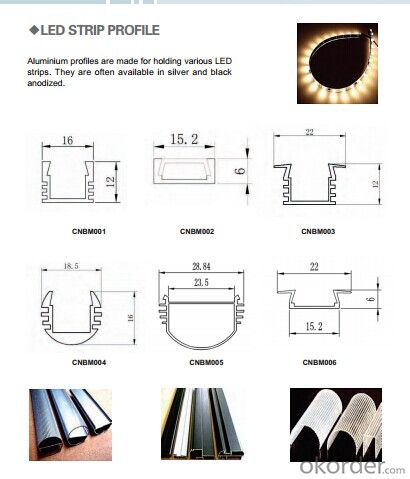
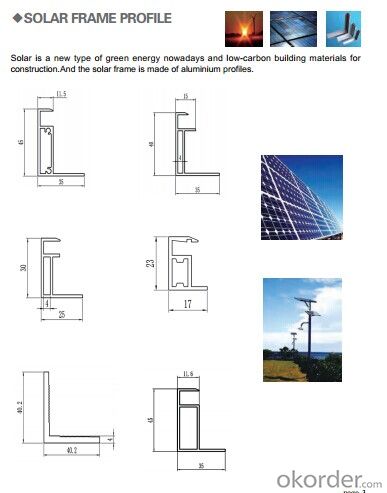
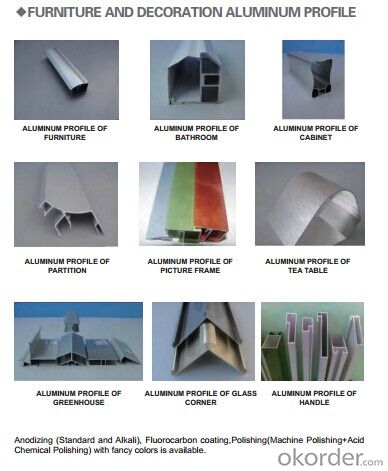
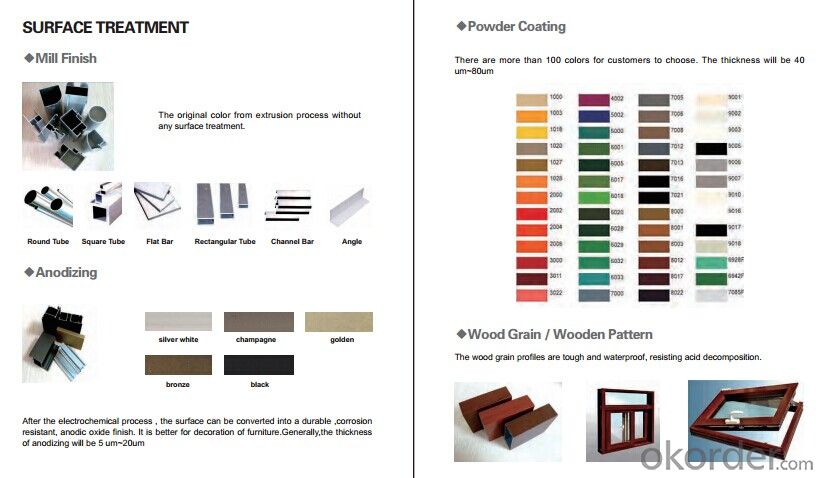
- Q: What precautions should be taken while handling aluminum profiles to ensure safety?
- <p>When working with aluminum profiles, it's important to take several safety measures. Always wear appropriate personal protective equipment (PPE), including safety glasses to protect your eyes from flying debris, gloves to protect your hands, and a dust mask to prevent inhalation of dust particles. Ensure that the work area is well-ventilated to avoid inhaling aluminum dust. Use proper tools for cutting and shaping aluminum profiles to minimize the risk of injury. Keep the work area clean and free from clutter to prevent tripping hazards. Be cautious when handling sharp edges and ends of cut aluminum profiles. Lastly, be aware of the weight of the aluminum profiles to avoid back injuries when lifting.</p>
- Q: How do aluminum profiles contribute to lightweight construction?
- Aluminum profiles contribute to lightweight construction by being strong and durable while also being significantly lighter in weight compared to other materials. This allows for the creation of structures that are both robust and easy to handle, reducing the overall weight of the construction. Additionally, aluminum profiles can be easily shaped and joined together, enabling designers to create complex and innovative lightweight designs.
- Q: What are the standards and regulations that control the use of aluminum profiles in construction?
- <p>Yes, there are several standards and regulations that govern the use of aluminum profiles in construction. These include international standards such as ISO 7039 and ISO 8039, which specify requirements for aluminum alloy extruded profiles. In the United States, the American Architectural Manufacturers Association (AAMA) provides guidelines, and the Aluminum Association sets standards for aluminum products. European standards like EN 755 and EN 12206 cover aluminum extrusions for general purposes and structural applications. Compliance with these standards ensures the safety, durability, and performance of aluminum profiles in construction projects.</p>
- Q: How to sell aluminum profile and accessories, how to find customers online?
- Go to the home network. There are all factories inside
- Q: This question asks for a list of various aluminum profiles that are utilized in the construction of building facades and cladding systems.
- <p>Aluminum profiles for facades and cladding systems come in various types, each serving specific purposes in construction. Common types include: 1. <strong>Aluminum Extrusions</strong>: Used for structural support and can be customized for specific design requirements. 2. <strong>Aluminum Channels</strong>: Often used for attaching panels or as a part of the support structure. 3. <strong>Aluminum Angles</strong>: Provide corner support and reinforcement. 4. <strong>Aluminum Flat Bars</strong>: Used for horizontal or vertical support in facade systems. 5. <strong>Aluminum Tubes</strong>: Can be used as a decorative element or for structural reinforcement. 6. <strong>Aluminum Louvers</strong>: Designed for sun shading and ventilation. 7. <strong>Aluminum Panels</strong>: Can be flat or profiled, used for the outer layer of the facade. 8. <strong>Aluminum Trims and Mouldings</strong>: Used for finishing and detailing around windows, doors, and edges. Each type is chosen based on the architectural design, structural requirements, and aesthetic preferences.</p>
- Q: This question asks if aluminum profiles can be utilized in sustainable construction projects and seeks an explanation of their application.
- <p>Yes, aluminum profiles can be used for green building projects. They are valued for their durability, recyclability, and energy efficiency. Aluminum profiles are lightweight, which reduces the load on structures and can contribute to energy savings in heating and cooling. They also have high thermal conductivity, which can be beneficial for heat transfer in building systems. Additionally, aluminum is 100% recyclable, meaning it can be repurposed without losing its properties, reducing waste and the need for new raw materials. This recyclability aligns with the principles of sustainable construction by promoting a circular economy and reducing the environmental impact of building materials.</p>
- Q: Can aluminum profiles be used for creating lighting fixtures?
- Indeed, lighting fixtures can be fashioned using aluminum profiles. The lightweight quality, durability, and resistance to corrosion render aluminum a favored material for such fixtures. Moreover, its malleability and feasibility for machining make it appropriate for crafting diverse designs and styles of lighting fixtures. Further, aluminum profiles can undergo powder coating or anodization to enrich their visual allure and furnish supplementary safeguard against deterioration. The adaptability and aesthetic charm of aluminum designate it as an optimal selection for producing lighting fixtures across an extensive array of environments, encompassing residential, commercial, and industrial settings.
- Q: The subject is aluminum bearing in what u ~ on both sides of the track?? How can the track be fitted into this slot? Both sides secure 50Mechanical expert answers!The subject is aluminum bearing in what u ~ on both sides of the track?? How can the track be fitted into this slot? How can the seat of fixed motor on both sides be connected with the section bar?
- A little understanding of machinery, not what you say master. Say, for reference only. No, please correct me.
- Q: Can aluminum profiles be used in the construction of greenhouses?
- Indeed, the utilization of aluminum profiles in the creation of greenhouses is possible. Due to its lightweight and enduring attributes, aluminum emerges as a commendable selection for constructing these structures. It possesses corrosion resistance, a crucial characteristic in the moisture-laden and damp atmosphere of greenhouses. The ease with which aluminum profiles can be fabricated and assembled lends itself to the flexibility of design and construction. Moreover, aluminum qualifies as an environmentally sustainable material, given its 100% recyclability, rendering it an eco-friendly choice for greenhouse construction. All in all, the practicality and dependability of aluminum profiles make them a viable option for erecting greenhouses.
- Q: Do aluminum profiles require any special tools or equipment for installation?
- Yes, aluminum profiles may require special tools and equipment for installation. Some of the tools commonly used include a miter saw or a circular saw with a non-ferrous metal blade for cutting the profiles to the desired length. A drill with the appropriate drill bits is necessary for creating holes for screws or other fasteners. Clamps or a vise may be needed to hold the profiles securely in place during installation. Additionally, a level, measuring tape, and a square are essential for ensuring accurate and precise installation. It is also important to have safety equipment such as safety glasses and gloves to protect against any potential hazards during the installation process. Overall, having the right tools and equipment is crucial to achieve a successful and efficient installation of aluminum profiles.
Send your message to us
China Powder Coated Aluminum Profiles - Manufacturing Aluminium Profile
- Loading Port:
- China Main Port
- Payment Terms:
- TT OR LC
- Min Order Qty:
- -
- Supply Capability:
- -
OKorder Service Pledge
OKorder Financial Service
Similar products
Hot products
Hot Searches
Related keywords
